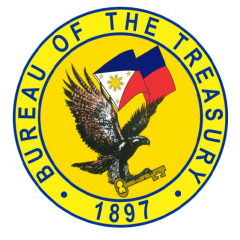
THE FLAG
Represents the National Coverage of the Bureau of the Treasury.
THE YEAR: 1897
Year the Treasury of the Philippines was established. On November 2, 1897, President Emilio Aguinaldo appointed Baldomero Aguinaldo as the Secretary of Treasury. Thus, the first National Treasury Office was constituted.
THE EAGLE
Symbolizes the need for the eagle’s eyes in watching over national funds, and eagle’s capacity to soar to greater heights of achievements, and strong claws to firmly hold the key to the national coffers.
THE KEY
Represents the key to the vaults where funds of the Republic of the Philippines are safely kept.
OUR CREDO
I am a Civil Servant to the Bureau of the Treasury.
As such, I believe in the Spirit of Service. It is my cherished principle and purpose. I value the trust and confidence reposed on me.
I offer back my loyalty to the institution. I value my integrity and professionalism. I commit to protect them.
I value the talents bestowed on me by God. I endeavor to sharpen them always and must bear fruit. I value my colleagues and my co-workers.
I strive to lead, inspire and be selfless. I give my whole in carrying out the duties and responsibilities entrusted to me
through,Competence and diligence in my work; Refinement in my words and deeds; Justice and fairness in my decisions;
Openness and teamwork in dealing with others; Accountability for all my actions. All this I will promote and nurture through my work,
in the service of my beloved Bureau, my country and God Almighty.
HISTORY
| 1897 | The Filipino nation had its first national Treasurer in the person of Baldomero Aguinaldo who was appointed by President Emilio Aguinaldo as Secretary of the Treasury. The imposition and collection of taxes became its principal functions. |
| 1900 | The Philippine Commission headed by William H. Taft created the Bureau of Insular Treasury which was tasked to receive and disburse public funds and account for the same. It also began the supervision of the country’s banks. |
| 1901 | The Bureau of Insular Treasury was placed under executive control of the Department of Finance and Justice by Section 3 of Act No. 222. |
| 1905 | The Bureau of Insular Treasury was renamed to Bureau of the Treasury by Act No. 1679 and given the additional task of coinage and currency supervision. |
| 1929 | The Bureau of Banking assumed the supervision of the country’s banks from the Bureau of the Treasury. The Bonding Law was passed based on a provision of the Administrative Code in 1917. |
| 1949 | Republic Act No. 265 transferred the functions of coinage and currency printing from the Bureau to the newly organized Central Bank of the Philippines. |
| 1965 | Treasury branches were opened throughout the country. |
| 1971 | The implementation of the Integrated Reorganization Plan of the government under RA 6130 reorganized the Bureau into three major services namely: Financial and Administrative Service, Cash Operations Service, and Public Debt Management. |
| 1976 | The Bureau’s Regional Offices were established: La Union – Region I, Tuguegarao – Region II, San Fernando – Region III, Batangas – Region IV, Manila – National Capital Region (NCR), Legaspi – Region V, Iloilo – Region VI, Cebu – Region VII, Tacloban – Region VIII, Zamboanga – Region IX, Cagayan de Oro – Region X, Davao – Region XI, and Cotabato – Region XII to coordinate the provincial offices. |
| 1986 | Executive Order 127 reorganized the Bureau with the following mandates: formulating the nation’s policies on financial management; public borrowing and capital market development; preparing annual projections of revenues, expenditures, cash position and borrowings in coordination with NEDA, DBM and BSP; managing the financial assets and controlling the liabilities of the National Government (NG); maintaining the books of accounts of all NG financial transactions; undertake the fidelity bonding of all accountable public officials; and administer the Fidelity Fund. |
| 1995 | The Bureau assumed the fiscal functions which RA 7653 mandates to be transferred from Bangko Sentral ng Pilipinas (BSP) to the Department of Finance, namely, the issue, service and redemption of Government Securities. The Bond Sinking Fund and the Securities Stabilization Fund began to be managed by the Bureau as fiscal agent. The electronic auction of the Philippine Government Securities called the Automated Debt Auction Processing System (ADAPS), the first of its kind in Asia, was introduced for a faster, more transparent and accurate auctions. |
| 1997 | The assumption of the management of Special Guaranty Fund by the BTr as fiscal agent. The introduction of the scripless electronic and real time transactions on government securities to eliminate the attendant risk as well as the cost of moving physical securities called the Registry of Scriptless Securities (RoSS). |
| 1998 | The democratization of government securities and empowerment of small savers through the offering of the Small Investors program (SIP). |
| 1999 | Offering of the Small-Denominated Treasury Bonds as part of Small Investors Program. Implemented Executive Order No.449 which further reorganized the BTr. |
| 2000 | Offering of the 25-year Treasury Bond. Only Japan and Philippines offer this longest Treasury Bond instrument in Asia. Established the BTr Provident Fund, Inc. as a non-stock and non-profit institution which provides additional benefits to BTr employees. |
| 2001 | Start of the listing and trading of small-denominated treasury bonds at the Philippine Stock Exchange on January 15, 2001 |
